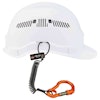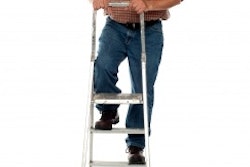
Ladders are such a commonplace item around the jobsite and in the home that we probably don't give their use much thought. Put it up, climb up, do your job, then climb down. However, improper use of ladders is consistently one of the top 10 most cited OSHA violations each year. And, more than 300 people die in ladder-related accidents on an annual basis, according to the American Ladder Institute (ALI). And many more sustain non-fatal injuries. So, it's worth giving proper ladder usage its due diligence.
How to Choose the Right Ladder for Your Construction Jobsite
Many of these ladder-related accidents are preventable through better safety planning and training. And just like with all other jobsite safety issues, it's a construction business owner's (and all his or her employees) responsibility to make sure employees are using tools and equipment correctly and in a safe manner.
So ALI has declared March 2017 to be the first ever National Ladder Safety Month. ALI wants to use National Ladder Safety month as a stepping stone to raise awareness of ladder safety and to decrease the number of ladder-related injuries and fatalities. During the month of March, ALI hopes to bring heightened awareness to the importance of safe ladder usage by providing resources, training and a national dialogue.
According to ALI, the goals of National Ladder Safety Month include:
- Increase the number of ladder safety training certificates issued by ALI
- Increase the frequency that ladder safety training modules are viewed (laddersafetytraining.org)
- Lower the rankings of ladder-related safety citations on OSHA's yearly "Top 10 Citations List"
- Decrease number of ladder-related injuries and fatalities
- Increase the number of competent ladder inspector trainings
- Increase the number of companies and individuals that inspect and properly dispose of old, damaged or obsolete ladders
If you'd like more information about how your company can participate in National Ladder Safety Month you can contact [email protected].
Encourage ladder safety
Encouraging ladder safety is not that difficult. And it's not just focusing on preventing falls from ladders — although that is a very serious safety issue. Ladder safety and proper ladder usage also includes the proper handling of ladders.
In fact, some of the most common ladder-related jobsite injuries include those from improper handling such as strains and sprains to the neck, shoulders, back, knees and ankles.
Also, make sure your employees are using the correct ladder for a job. Workers should be using ladders with load capacity ratings for what they need. Exceeding the maximum load rating is a big safety risk.
Using a ladder may seem fairly intuitive, but there are safety measures your employees should take when using them on the construction jobsite. Extension ladders should be tied off at the top, middle and bottom to prevent ladder movement or slipping. Make sure the structure supporting the ladder is capable of that support. Also, a second person should act as a spotter and hold the ladder while it is in use. Extension ladders should also extend three feet past the platform being climbed to.
It is also recommended ladder users abide by the 1:4 ratio regarding the distance the ladder's base must be from the foundation. Position the base of the ladder one foot away for every four feet of height to where the ladder rests This ratio is important because the angle it creates utilizes the ladder's strength and gives optimum balance when climbing.
Other safety tips include:
- Place ladders on a flat, secure, hard surface and non-movable base
- Do not climb higher than the recommended rung for that ladder (OSHA recommends not climbing higher than the third rung from the top)
- Always face the ladder when climbing or descending
- Keep your torso between the ladder rails and do not overreach
- Keep hands free of materials while climbing ladders
- Make sure shoes and ladder rungs are free of slippery materials
- Avoid using a metal ladder near power lines or exposed energized electrical equipment
- Always maintain a three-point (two hands and one foot or two feet and one hand) contact on the ladder when climbing
- Do not more or shift a ladder while a person or equipment is on the ladder
Let's not forget the importance of properly maintaining your ladders in order to keep them operating as safe tools. Ladders should be inspected before and after each use. Look for broken or frozen joints or latches as well as cracks, broken welds, rough spots and burrs. Wooden ladders should be inspected for cracked wood, splinters, rot, and broken or loose hardware.
Will you take part in National Ladder Safety Month and make sure your employees are using ladders safely and correctly?
What does your company already do to ensure proper ladder safety and usage?
Share your thoughts and ideas in the comment section below.




















